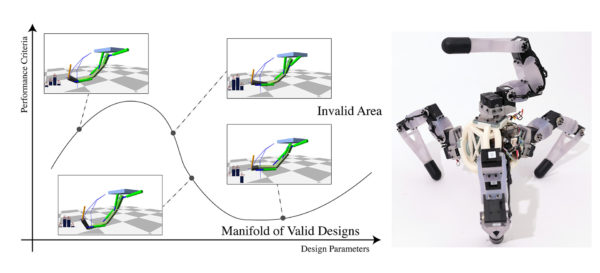Abstract

We present a novel computational approach to optimizing the morphological design of robots. Our framework takes as input a parameterized robot design as well as a motion plan consisting of trajectories for end-effectors and, optionally, for its body. The algorithm optimizes the design parameters including link lengths and actuator placements whereas concurrently adjusting motion parameters such as joint trajectories, actuator inputs, and contact forces. Our key insight is that the complex relationship between design and motion parameters can be established via sensitivity analysis if the robots movements are modeled as spatiotemporal solutions to an optimal control problem. This relationship between form and function allows us to automatically optimize the robot design based on specifications expressed as a function of actuator forces or trajectories. We evaluate our model by computationally optimizing four simulated robots that employ linear actuators, four-bar linkages, or rotary servos. We further validate our framework by optimizing the design of two small quadruped robots and testing their performances using hardware implementations.
Additional Content
Copyright Notice
The documents contained in these directories are included by the contributing authors as a means to ensure timely dissemination of scholarly and technical work on a non-commercial basis. Copyright and all rights therein are maintained by the authors or by other copyright holders, notwithstanding that they have offered their works here electronically. It is understood that all persons copying this information will adhere to the terms and constraints invoked by each author’s copyright. These works may not be reposted without the explicit permission of the copyright holder.